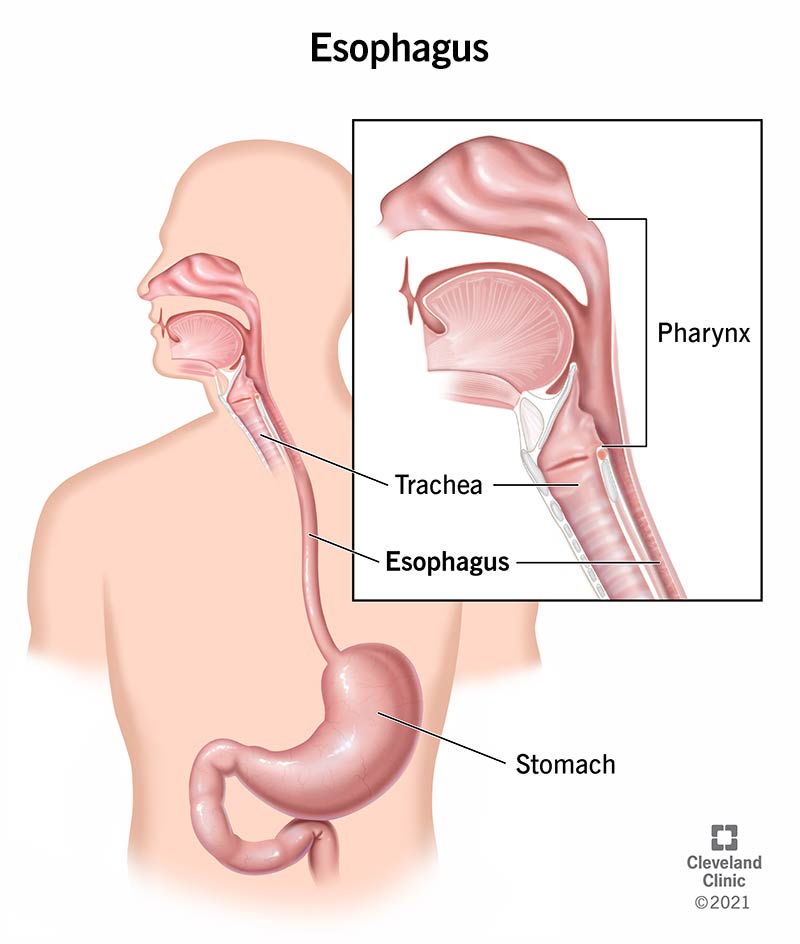Your esophagus is a hollow, muscular tube that carries food and liquid from your throat to your stomach. Muscles in your esophagus propel food down to your stomach. One of the most common symptoms of esophagus problems is heartburn, a burning sensation in the middle of your chest. Problems with the esophagus include acid reflux and GERD.
Advertisement
Cleveland Clinic is a non-profit academic medical center. Advertising on our site helps support our mission. We do not endorse non-Cleveland Clinic products or services. Policy

The esophagus is the hollow, muscular tube that passes food and liquid from your throat to your stomach. It functions as part of your digestive system.
Advertisement
Cleveland Clinic is a non-profit academic medical center. Advertising on our site helps support our mission. We do not endorse non-Cleveland Clinic products or services. Policy
The primary function of your esophagus is to carry food and liquid from your mouth to your stomach. When you swallow, food and liquid first move from your mouth to your throat (pharynx). A small muscular flap called the epiglottis closes to prevent food and liquid from going down the “wrong pipe” — your windpipe (trachea). Another small flap called the uvula helps prevent liquid from passing upward into your nasal cavity.
At the opening of your upper esophagus, there’s a ring-shaped muscle called the upper esophageal sphincter. Your upper esophageal sphincter senses when food or liquid is coming toward it. When it gets the signal, the sphincter relaxes or opens so that food can enter your esophagus. When there’s no food or liquid in sight, it stays closed.
Once inside your esophagus, waves of muscular contractions (peristalsis) push the food downward. The food passes through your diaphragm and reaches your lower esophagus.
At the opening of your lower esophagus, there’s another ring-shaped muscle called the lower esophageal sphincter (LES). Like the upper esophageal sphincter (UES), it senses when food and liquid are coming. It relaxes and lets the food pass through to your stomach. When no food or liquid is coming its way, it usually stays shut to prevent stomach acid and digestive juices from getting into your esophagus.
Advertisement
The esophagus is located in the center of your chest in an area called the mediastinum. It lies behind your windpipe (trachea) and in front of your spine.
The average adult esophagus is about 10 to 13 inches long. It’s about three-fourths of an inch thick at its smallest point.
Your trachea (windpipe) and your esophagus are both muscular tubes located within your neck. However, they have two very different functions. Your trachea is part of your respiratory system, and your esophagus is part of your digestive system. Your trachea transports air in and out of your lungs, whereas your esophagus transports food and liquid from your throat to your stomach.
The most common problem that can affect your esophagus is acid reflux. Acid reflux occurs when your lower esophageal sphincter opens when it’s not supposed to. This allows stomach acid and digestive juices to flow back from your stomach into your esophagus. This can cause inflammation and heartburn.
Gastroesophageal reflux disease (GERD) is a more severe form of acid reflux. With GERD, stomach acid persistently flows back into your esophagus. Besides heartburn, some people develop a cough, chest pain, hoarseness, bad breath and/or trouble swallowing. You may feel like there’s a lump in the back of your throat. Over time, GERD can cause significant damage to your esophagus.
Other problems that can affect your esophagus include:
Rarely, esophageal cancer can occur. Two types of cancer can develop in your esophagus:
Advertisement
One of the most common symptoms of esophagus problems is heartburn. People describe heartburn as a burning feeling in the center of your chest behind your breastbone (sternum).
Other symptoms of esophagus problems depend on the cause. They can include:
Your healthcare provider may recommend one or more of the following tests to determine if you have an esophagus condition:
Advertisement
Treatment for esophagus problems depends on the cause. Some esophagus problems can be treated with over-the-counter medication or diet changes. Other conditions may require prescription medication, procedures or surgery.
Common medications for esophagus conditions include:
Some conditions may require special procedures or surgery to correct the issue. These can include:
Advertisement
Treatment for esophageal cancer depends on the severity of the disease.
Your esophagus is a hollow, muscular tube that carries food and liquid from your throat to your stomach. Muscles at the top and bottom of your esophagus play an important part in the process. If the lower muscle doesn’t work properly, it can cause health issues with your esophagus, including acid reflux, GERD and achalasia. Other problems with your esophagus can occur as well. Talk to your healthcare provider if you have symptoms including heartburn, chest pain and difficulty swallowing. You may have a condition in your esophagus that needs to be addressed.
Cleveland Clinic’s primary care providers offer lifelong medical care. From sinus infections and high blood pressure to preventive screening, we’re here for you.

Last reviewed on 08/04/2021.
Learn more about the Health Library and our editorial process.